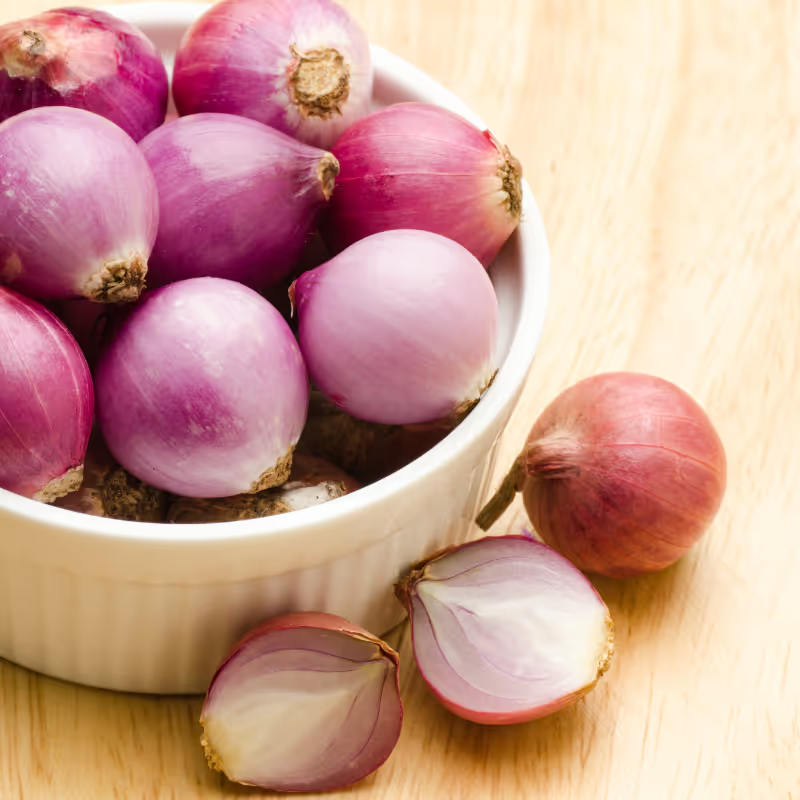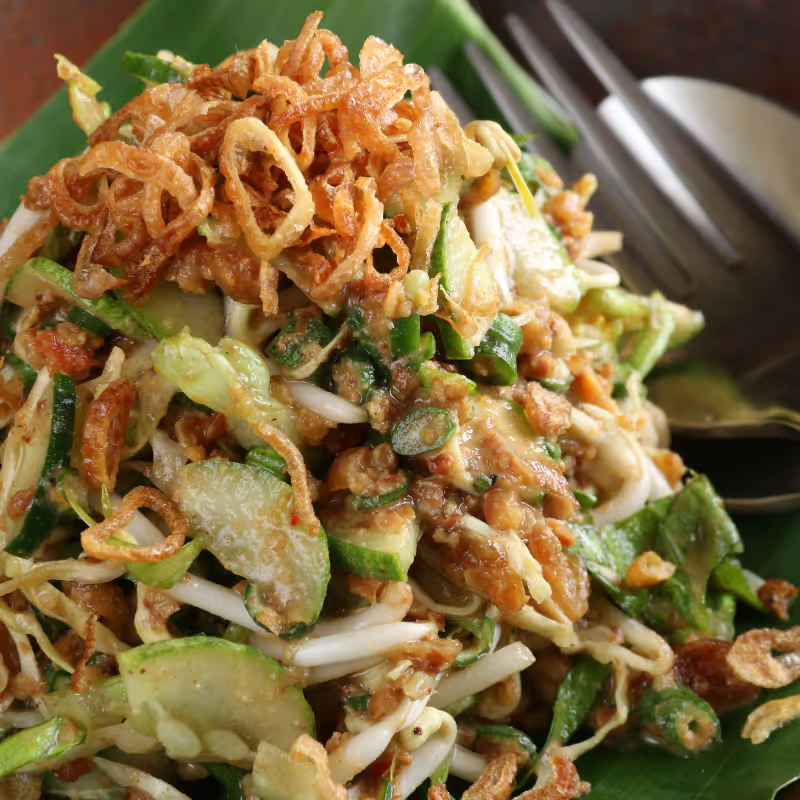What Does it Taste Like?
Shallots are often described as a cross between onions and garlic, but they have their own unique flavor that is more subtle and refined. They have a slight bite when raw, but they become soft and caramelized when cooked, releasing a rich and aromatic sweetness. Shallots have a similar texture to onions, with thin layers that can be easily peeled and chopped. They come in different shapes and sizes, ranging from round and plump to long and tapered. Some shallots have a coppery-brown skin, while others have a grayish-purple hue.
Varieties we grow

Creme Brulee
The Creme Brulee variety of shallot is characterized by its elongated shape and pale, golden-brown skin. Its flesh is smooth and creamy with a delicate, sweet flavor that is milder than regular onions. This variety is ideal for both raw and cooked applications, adding a subtle, refined taste to dressings, sauces, and sautés.
Why Should I Eat It?
Shallots are not only delicious, but also nutritious. They are low in calories and high in fiber, vitamin C, potassium, and antioxidants. They also contain compounds called organosulfur, which have anti-inflammatory, antibacterial, and antifungal properties. Studies have shown that shallots can help lower blood pressure, cholesterol, and blood sugar levels, as well as protect against certain types of cancer.
Shallots

August - April
Have you ever wondered what those small, elongated onions are in the produce section of your grocery store? They are shallots, a type of allium that belongs to the same family as onions, garlic, leeks, and chives. Shallots have a mild and sweet flavor that can enhance any savory dish, from salads and sauces to soups and stews.
Recommended Storage
How Do I Store It?
Short Term
Shallots can last for several weeks if stored properly. The best way to store shallots short term is to keep them in a cool, dry, and dark place, such as a pantry, a cupboard, or a drawer. Avoid storing them in the refrigerator, as the moisture and cold can make them sprout or rot. Also, avoid storing them near potatoes, as they can make each other spoil faster. Keep the shallots in their original mesh bag or a paper bag, and check them regularly for signs of spoilage, such as mold, softness, or sprouting.
Long Term
- Freeze: You can freeze shallots for up to six months, but they will lose some of their texture and flavor. To freeze shallots, peel and chop them, then spread them in a single layer on a baking sheet. Freeze them until firm, then transfer them to a freezer-safe bag or container. Use them directly from the freezer, without thawing, for cooked dishes.
- Pickle: You can pickle shallots for up to a year, and they will retain their crunch and tang. To pickle shallots, follow the method described above in the section on how to cook shallots. Store the pickled shallots in the refrigerator, and use them as a condiment or a garnish for salads, sandwiches, cheese boards, and more.
- Dehydrate: You can dehydrate shallots for up to a year, and they will become crisp and concentrated. To dehydrate shallots, peel and slice them thinly, then spread them in a single layer on a baking sheet. Bake them in a preheated oven at 150°F (65°C) for 3 to 4 hours, or until they are dry and brittle. Alternatively, you can use a dehydrator and follow the manufacturer’s instructions. Store the dehydrated shallots in an airtight container in a cool, dry, and dark place, and use them as a seasoning or a snack.
How Do I Cook It?
Shallots can be cooked in various ways, depending on the desired result. Here are six easy methods to try:
- Sauté: This is the most common way to cook shallots, and it works well for dishes that need a base of flavor. Simply peel and dice the shallots, then heat some oil or butter in a skillet over medium-high heat. Add the shallots and cook, stirring occasionally, until they are soft and golden, about 15 minutes. You can season them with salt, pepper, herbs, or spices as you like.
- Roast: Roasting shallots brings out their natural sweetness and makes them tender and caramelized. Peel and halve the shallots, then toss them with some oil, salt, pepper, and herbs in a baking dish. Roast them in a preheated oven at 375°F (190°C) for 25 to 30 minutes, or until they are browned and soft.
- Fry: Frying shallots gives them a crispy and crunchy texture that can be used as a garnish or a snack. Peel and slice the shallots thinly, then toss them with some cornstarch or flour to coat. Heat some oil in a deep-fryer or a large pot over high heat. Fry the shallots in batches until they are golden and crisp, about 5 minutes. Drain them on paper towels and sprinkle with salt.
- Braise: Braising shallots makes them soft and succulent, and infuses them with the flavor of the liquid they are cooked in. Peel and trim the shallots, then place them in a single layer in a large skillet or a Dutch oven. Add enough liquid (such as broth, wine, or water) to barely cover the shallots, and bring to a boil. Reduce the heat and simmer, covered, until the shallots are tender and the liquid is reduced, about 20 to 30 minutes. You can add some sugar, vinegar, or herbs to the liquid for extra flavor.
- Grill: Grilling shallots gives them a smoky and charred flavor that is perfect for summer. Peel and skewer the shallots, then brush them with some oil and season with salt, pepper, and herbs. Grill them over medium-high heat, turning occasionally, until they are charred and soft, about 15 to 20 minutes.
- Pickle: Pickling shallots preserves them and adds a tangy and crunchy flavor that can complement many dishes. Peel and slice the shallots, then pack them in a sterilized jar. In a small saucepan, bring some vinegar, water, sugar, salt, and spices (such as mustard seeds, peppercorns, and bay leaves) to a boil. Pour the hot brine over the shallots, leaving some headspace. Seal the jar and let it cool, then refrigerate for at least a week before using.

Recommended Recipes
What Goes Well With It?
Shallots have a versatile flavor that can pair well with many ingredients. Here are some of the best flavor pairings for shallots:
- Herbs: Shallots and herbs are a match made in heaven, as they both add freshness and aroma to dishes. Some of the best herbs to pair with shallots are parsley, thyme, rosemary, sage, basil, and cilantro.
- Cheese: Shallots and cheese are another classic combination, as they balance each other’s richness and sharpness. Some of the best cheeses to pair with shallots are goat cheese, blue cheese, Parmesan, Gruyère, and feta.
- Mushrooms: Shallots and mushrooms are a savory and earthy duo, as they both have a meaty and umami flavor. Some of the best mushrooms to pair with shallots are button, cremini, shiitake, oyster, and porcini.
- Wine: Shallots and wine are a sophisticated and elegant pair, as they both enhance and complement each other’s flavor. Some of the best wines to pair with shallots are white wines, such as Chardonnay, Sauvignon Blanc, and Pinot Grigio, or light red wines, such as Pinot Noir, Merlot, and Beaujolais.
- Vinegar: Shallots and vinegar are a tangy and zesty pair, as they both add acidity and brightness to dishes. Some of the best vinegars to pair with shallots are balsamic, red wine, apple cider, and sherry.
